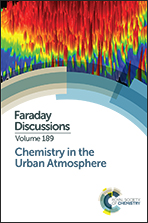The “Parade Blue”: effects of short-term emission control on aerosol chemistry†
Abstract
The strict control on emissions implemented in Beijing, China, during the 2015 China Victory Day Parade (V-day Parade) to commemorate the 70th Anniversary of Victory in World War II, provided a good opportunity to investigate the relationship between emission sources and aerosol chemistry in a heavily polluted megacity. From August 11 to September 3, 2015, an Aerosol Chemical Speciation Monitor was deployed in urban Beijing, together with other collocated instruments, for the real-time measurement of submicron aerosol characteristics. The average PM1 mass concentration was 11.3 (±6.7) μg m−3 during the V-day Parade, 63.5% lower than that before the V-day Parade. Differently to the relatively smaller decrease of organics (53%), secondary inorganic aerosols (sulfate, nitrate and ammonium) showed significant reductions of 65–78% during the V-day Parade. According to the positive matrix factorization results, primary organic aerosol (POA) from traffic and cooking emissions decreased by 41.5% during the parade, whereas secondary organic aerosol (SOA) presented a much greater reduction (59%). The net effectiveness of emission control measures was investigated further under comparable weather conditions before and during the parade. By excluding the effects of meteorological parameters, the total PM1 mass was reduced by 52–57% because of the emission controls. Although the mass concentrations of aerosol species were reduced substantially, the PM1 bulk composition was similar before and during the control period as a consequence of synergetic control of various precursors. The emission restrictions also suppressed the secondary formation processes of sulfate and nitrate, indicated by the substantially reduced SOR and NOR (molar ratios of sulfate or nitrate to the sums of the sulfate and SO2 or nitrate and NO2) during the event. The study also explored the influence of emission controls on the evolution of organic aerosol using the mass ratios of SOA/POA and oxygen-to-carbon ratios. The results showed that for northwesterly airflows, emission restrictions during the V-day Parade also reduced the oxidation degree of organic aerosol.
- This article is part of the themed collection: Chemistry in the Urban Atmosphere

 Please wait while we load your content...
Please wait while we load your content...